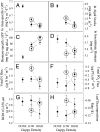Local adaptation in Trinidadian guppies alters ecosystem processes
- PMID: 20133670
- PMCID: PMC2840427
- DOI: 10.1073/pnas.0908023107
Local adaptation in Trinidadian guppies alters ecosystem processes
Abstract
Theory suggests evolutionary change can significantly influence and act in tandem with ecological forces via ecological-evolutionary feedbacks. This theory assumes that significant evolutionary change occurs over ecologically relevant timescales and that phenotypes have differential effects on the environment. Here we test the hypothesis that local adaptation causes ecosystem structure and function to diverge. We demonstrate that populations of Trinidadian guppies (Poecilia reticulata), characterized by differences in phenotypic and population-level traits, differ in their impact on ecosystem properties. We report results from a replicated, common garden mesocosm experiment and show that differences between guppy phenotypes result in the divergence of ecosystem structure (algal, invertebrate, and detrital standing stocks) and function (gross primary productivity, leaf decomposition rates, and nutrient flux). These phenotypic effects are further modified by effects of guppy density. We evaluated the generality of these effects by replicating the experiment using guppies derived from two independent origins of the phenotype. Finally, we tested the ability of multiple guppy traits to explain observed differences in the mesocosms. Our findings demonstrate that evolution can significantly affect both ecosystem structure and function. The ecosystem differences reported here are consistent with patterns observed across natural streams and argue that guppies play a significant role in shaping these ecosystems.
Conflict of interest statement
The authors declare no conflict of interest.
Figures




Similar articles
-
Population size-structure-dependent fitness and ecosystem consequences in Trinidadian guppies.J Anim Ecol. 2015 Jul;84(4):955-68. doi: 10.1111/1365-2656.12353. Epub 2015 Mar 18. J Anim Ecol. 2015. PMID: 25704755
-
Direct and indirect ecosystem effects of evolutionary adaptation in the Trinidadian guppy (Poecilia reticulata).Am Nat. 2012 Aug;180(2):167-85. doi: 10.1086/666611. Am Nat. 2012. PMID: 22766929
-
Experimental evaluation of evolution and coevolution as agents of ecosystem change in Trinidadian streams.Philos Trans R Soc Lond B Biol Sci. 2009 Jun 12;364(1523):1617-28. doi: 10.1098/rstb.2009.0016. Philos Trans R Soc Lond B Biol Sci. 2009. PMID: 19414475 Free PMC article.
-
Experimental studies of evolution in guppies: a model for understanding the evolutionary consequences of predator removal in natural communities.Mol Ecol. 2008 Jan;17(1):97-107. doi: 10.1111/j.1365-294X.2007.03474.x. Epub 2008 Aug 23. Mol Ecol. 2008. PMID: 17725576 Review.
-
Compiling forty years of guppy research to investigate the factors contributing to (non)parallel evolution.J Evol Biol. 2022 Nov;35(11):1414-1431. doi: 10.1111/jeb.14086. Epub 2022 Sep 13. J Evol Biol. 2022. PMID: 36098479 Review.
Cited by
-
feedback between population and evolutionary dynamics determines the fate of social microbial populations.PLoS Biol. 2013;11(4):e1001547. doi: 10.1371/journal.pbio.1001547. Epub 2013 Apr 30. PLoS Biol. 2013. PMID: 23637571 Free PMC article.
-
Ecological and evolutionary effects of stickleback on community structure.PLoS One. 2013;8(4):e59644. doi: 10.1371/journal.pone.0059644. Epub 2013 Apr 3. PLoS One. 2013. PMID: 23573203 Free PMC article.
-
Investment in boney defensive traits alters organismal stoichiometry and excretion in fish.Oecologia. 2016 Aug;181(4):1209-20. doi: 10.1007/s00442-016-3599-0. Epub 2016 Apr 13. Oecologia. 2016. PMID: 27075487
-
Linking genes to communities and ecosystems: Daphnia as an ecogenomic model.Proc Biol Sci. 2012 May 22;279(1735):1873-82. doi: 10.1098/rspb.2011.2404. Epub 2012 Feb 1. Proc Biol Sci. 2012. PMID: 22298849 Free PMC article.
-
Recent evolutionary history predicts population but not ecosystem-level patterns.Ecol Evol. 2019 Nov 28;9(24):14442-14452. doi: 10.1002/ece3.5879. eCollection 2019 Dec. Ecol Evol. 2019. PMID: 31938531 Free PMC article.
References
-
- Hairston NG, Jr, Hairston NG., Sr Cause-effect relationships in energy flow, trophic structure, and interspecific interactions. Am Nat. 1993;142:379–411.
-
- Vanni MJ. Nutrient cycling by animals in freshwater ecosystems. Annu Rev Ecol Syst. 2002;33:341–370.
-
- Sterner RW, Elser JJ. Ecological Stoichiometry: The Biology of Elements from Molecules to the Biosphere. New Jersey: Princeton Univ Press; 2002.
-
- Flecker AS. Ecosystem engineering by a dominant detritivore in a diverse tropical ecosystem. Ecology. 1996;77:1845–1854.
-
- Pringle CM, et al. Effects of omnivorous shrimp in a montane tropical stream: sediment removal, disturbance of sessile invertebrates and enhancement of understory algal biomass. Oecologia. 1993;93:1–11. - PubMed
Publication types
MeSH terms
LinkOut - more resources
Full Text Sources

